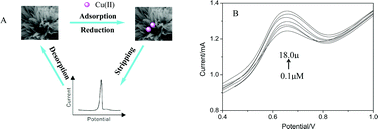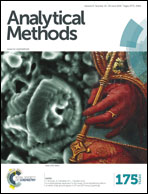Facile synthesis of a 3D MnO2 nanowire/Ni foam electrode for the electrochemical detection of Cu(ii)
Abstract
MnO2 nanowire arrays grown on Ni foam were successfully synthesized using a one-step hydrothermal approach and then directly applied as the electrode for a heavy metal sensor. Additionally, serving as a Cu(II) sensor, the MnO2 nanowire arrays grown on a Ni foam electrode exhibited remarkable electrocatalytic activity towards Cu(II) oxidation with a high limit of detection and sensitivity of 0.17 μM and 59.5 μA μM−1, respectively. Furthermore, the MnO2 nanowire arrays grown on Ni foam electrodes for sensing exhibited high cycling stability, long-term durability and reproduction stability. These results are attributed to the unique features of the MnO2 nanowire arrays grown on Ni foam electrodes, which enable the surface of the MnO2 nanowires grown on Ni foam to become highly accessible to the metal ion and provide more void volume for reactions with metal ions. This work suggests that there is great potential in employing the MnO2 nanowire arrays grown on Ni foam as heavy metal ion sensors.


 Please wait while we load your content...
Please wait while we load your content...